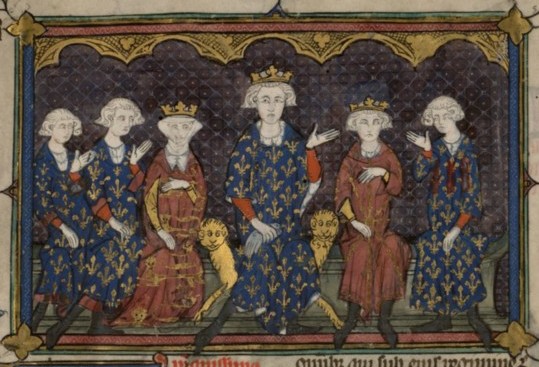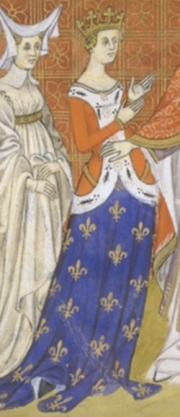This is the story of how some little purses prevented women from ever inheriting the French throne.
The story starts when the very beautiful Queen of England personally embroidered three purses for her lively young sisters-in-law: Marguerite, Jeanne and Blanche. Born a princess of France, Isabella gave these special gifts to them while on a visit home. Isabella had been sent to England as a little girl, so she must have been excited to spend time with her own family—her powerful father King Philip the Fair, her three handsome brothers and their three wives, all of whom were princesses of Burgundy. Blanche and Jeanne were sisters and Marguerite was their cousin.
Since the death of Isabella’s mother, the three Burgundian princesses had made the French court a place for frivolity with fun-filled parties and risqué fashions. Nineteen-year-old Isabella must have enjoyed their company, particularly since her English sisters-in-law were all much older than she.
Alas, although Isabella had to return to Britain, many Frenchman were frequently at her husband’s court. Two dashing knights were visiting just a few months later: the dashing d’Aulnay brothers, Philip and Gautier. Although not nearly as handsome as her own husband King Edward II, the brothers certainly caught her eye. They were amusing to admire until Isabella noticed something odd. On each brother’s belt there hung a familiar little purse—the very purses that Isabella had recently given to Blanche and Marguerite.
To say that Isabella was angry is probably putting it mildly. She might have been slightly offended by the re-gifting, but she was more likely infuriated that two wives of French princes—her own brothers—were granting such favors to men who weren’t their husbands. What could it mean?
Isabella didn’t immediately tell her father and brothers. She had little evidence to prove her worst fears. Soon, however, others began to question the jovial Burgundian trios’ too boisterous behavior. Whispers, perhaps outright accusations, reached King Philip’s ears. Isabella finally shared her own suspicions. A cautious, but politically vicious man, Philip gathered information. He had his daughters-in-law and their friends followed. The trail quickly led straight to the Tour de Nesle, an old fortress on the River Seine, which had been turned into a love den.
The d’Aulnay brothers tried to escape Philip’s reach, but they failed. Instead, they were tortured just as the Knights Templar had so recently been tormented by the King. This time, however, more than money, power, and religion were at stake. The very fate of the Capetian dynasty was on the line, for if either princess conceived a child by her lover, it could be passed off as an heir to the throne.
The d’Aulnay brothers did not last long under their brutal inquisition. They confessed everything. For their lusty crimes against the king, they were publicly castrated, flayed alive and then decapitated. Their mistresses faced a more private trial before the Paris Parlement. All three young women stood accused. Jeanne admitted that she knew about the affairs but had never been unfaithful herself. Her husband, the second son Prince Philip, believed her and pleaded for her. Blanche and Marguerite had no such defenders. They were both found guilty. Their lives were spared but they were humiliated by being shaved bald and were imprisoned in the dank and gloomy Chateau Gaillard. Jeanne was punished by being placed under house arrest at Dourdan. Within a year, she was reunited with her husband and five children at court.
Just months after the Tour de Nesle Affair, King Philip died and his eldest son became King Louis X. Because his wife Marguerite’s affair had called into question the legitimacy of their only child, a daughter named Jeanne, Louis needed to marry again quickly. With Marguerite still alive at Chateau Gaillard, it would be difficult for him to find another bride. Then, Marguerite conveniently died. Perhaps too conveniently. It might have been the harsh conditions of being imprisoned underground or it might have been murder. Nevertheless, her death could not have come at a better time for Louis, who married his second wife just five days later.
Louis managed to impregnate his new wife very quickly, but his athletic prowess soon got the best of him. After an intense game of tennis—his favorite sport—he grew ill and died. He had been king for less than two years. France eagerly awaited the birth of the heir, a little boy name John, who died within a week.
What was the country to do? Louis’ daughter Jeanne was still alive, though not quite four years old. So, King Philip IV’s second soon assumed the throne as King Philip V, with his wife Jeanne of Burgundy at his side. He quickly convened the three estates and had them affirm that women could not inherit the throne, allegedly based on historical precedence from the time of the Frankish kings. Called the Salic Law, this legal decision barred the orphaned princess from the throne and confirmed the new King Philip’s regal rights, but it had some unintended consequences. At the time, Philip’s heir was his own son and namesake, but five years later, the little prince died. When the king died the next year, he left behind four daughters who, because of their father’s insistence, could not inherit the throne.
Instead, Philip’s brother, Charles, husband of the still-imprisoned Blanche of Burgundy became king. Charles finally managed to have the marriage annulled and he remarried. Blanche, despite the dreadful conditions which had perhaps led to her cousin’s death at Chateau Gaillard, carried on her promiscuous ways: she conceived a child by one of her jailers. Nevertheless, she ultimately repented and was allowed to become a nun. She lived until the ripe old age of 30.
As for Charles, despite two more wives, he died without sons and the Salic Law prevented his two surviving daughters from ascending the throne in 1328, just 14 years after the Affair of the Tour de Nesle.
In England, the only surviving child of King Philip IV, Queen Isabella thought she saw a loophole in the Salic Law. Although she could not inherit the throne, perhaps her son could. That question would launch the Hundred Years’ War between France and England.
Perhaps one of the greatest ironies of the entire Tour de Nesle Affair, however, is perhaps that Queen Isabella had become the most infamous adulteress in the world. Although she had pointed fingers at her sisters-in-law, she also engaged in a well-known extramarital affair, she and her lover led a rebellion against her husband, forced his abdication and had him executed.
 |
| Philip the Fair with his children and his brother |
Since the death of Isabella’s mother, the three Burgundian princesses had made the French court a place for frivolity with fun-filled parties and risqué fashions. Nineteen-year-old Isabella must have enjoyed their company, particularly since her English sisters-in-law were all much older than she.
Alas, although Isabella had to return to Britain, many Frenchman were frequently at her husband’s court. Two dashing knights were visiting just a few months later: the dashing d’Aulnay brothers, Philip and Gautier. Although not nearly as handsome as her own husband King Edward II, the brothers certainly caught her eye. They were amusing to admire until Isabella noticed something odd. On each brother’s belt there hung a familiar little purse—the very purses that Isabella had recently given to Blanche and Marguerite.
To say that Isabella was angry is probably putting it mildly. She might have been slightly offended by the re-gifting, but she was more likely infuriated that two wives of French princes—her own brothers—were granting such favors to men who weren’t their husbands. What could it mean?
 |
| Tour de Nesle |
The d’Aulnay brothers tried to escape Philip’s reach, but they failed. Instead, they were tortured just as the Knights Templar had so recently been tormented by the King. This time, however, more than money, power, and religion were at stake. The very fate of the Capetian dynasty was on the line, for if either princess conceived a child by her lover, it could be passed off as an heir to the throne.
The d’Aulnay brothers did not last long under their brutal inquisition. They confessed everything. For their lusty crimes against the king, they were publicly castrated, flayed alive and then decapitated. Their mistresses faced a more private trial before the Paris Parlement. All three young women stood accused. Jeanne admitted that she knew about the affairs but had never been unfaithful herself. Her husband, the second son Prince Philip, believed her and pleaded for her. Blanche and Marguerite had no such defenders. They were both found guilty. Their lives were spared but they were humiliated by being shaved bald and were imprisoned in the dank and gloomy Chateau Gaillard. Jeanne was punished by being placed under house arrest at Dourdan. Within a year, she was reunited with her husband and five children at court.
Just months after the Tour de Nesle Affair, King Philip died and his eldest son became King Louis X. Because his wife Marguerite’s affair had called into question the legitimacy of their only child, a daughter named Jeanne, Louis needed to marry again quickly. With Marguerite still alive at Chateau Gaillard, it would be difficult for him to find another bride. Then, Marguerite conveniently died. Perhaps too conveniently. It might have been the harsh conditions of being imprisoned underground or it might have been murder. Nevertheless, her death could not have come at a better time for Louis, who married his second wife just five days later.
Louis managed to impregnate his new wife very quickly, but his athletic prowess soon got the best of him. After an intense game of tennis—his favorite sport—he grew ill and died. He had been king for less than two years. France eagerly awaited the birth of the heir, a little boy name John, who died within a week.
 |
| Blanche |
As for Charles, despite two more wives, he died without sons and the Salic Law prevented his two surviving daughters from ascending the throne in 1328, just 14 years after the Affair of the Tour de Nesle.
 |
| Queen Isabella and her lover at the head of an army. |
Perhaps one of the greatest ironies of the entire Tour de Nesle Affair, however, is perhaps that Queen Isabella had become the most infamous adulteress in the world. Although she had pointed fingers at her sisters-in-law, she also engaged in a well-known extramarital affair, she and her lover led a rebellion against her husband, forced his abdication and had him executed.
There was a TV historical drama mini-series of a novel by the same title, "Les Rois Maudits" on France 2 several years ago. It treated this time period.
ReplyDeleteBy the way, I've been reading your blog for some time and enjoying it!
Thanks, Elisa! Glad you enjoy it. Wish I had more time to add more content!!
ReplyDelete